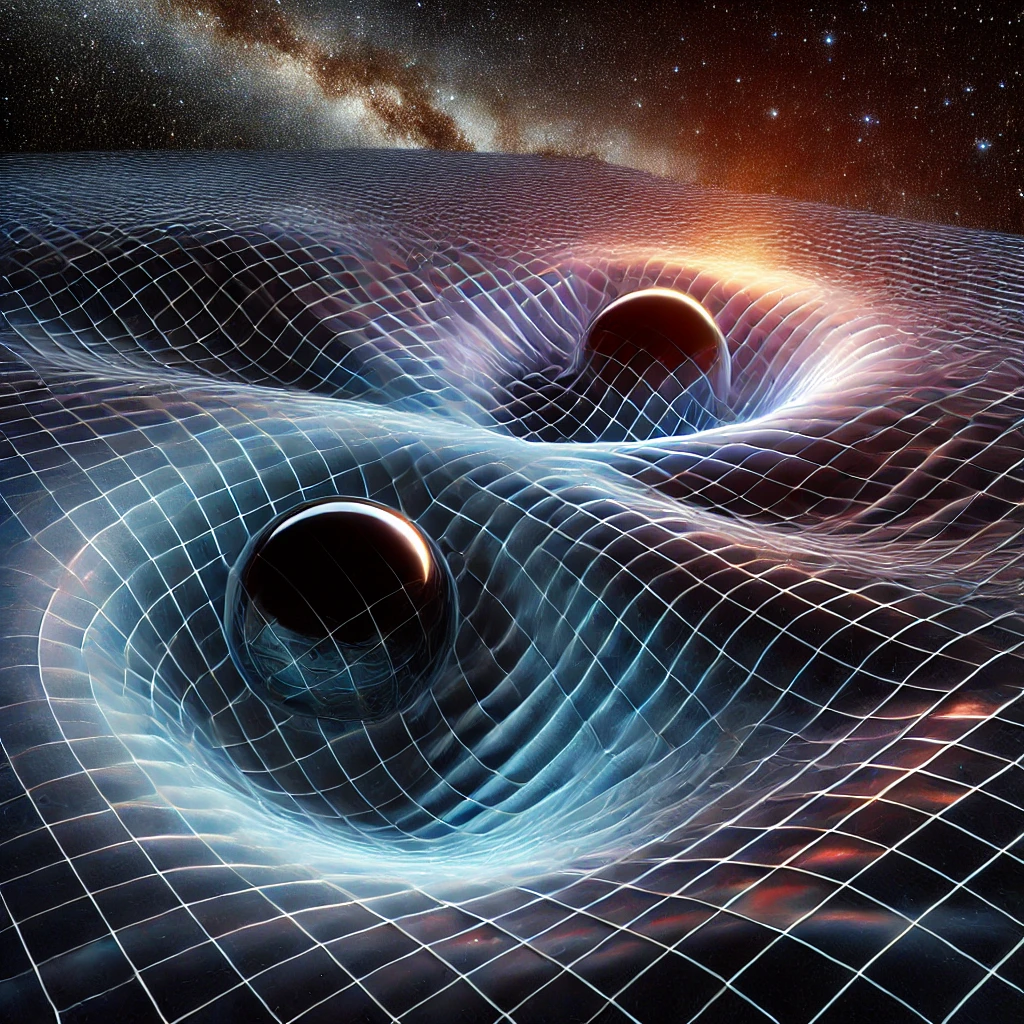Greetings, fellow cosmic explorers! Captain Nova here, broadcasting from the Odyssey Explorer on Day 49 of our 100 Days of Space Exploration journey. Today, we dive into one of the most mind-bending concepts in modern physics: space-time and gravitational waves. These fundamental aspects of the universe shape how we understand gravity, time, and even the very fabric of reality. So, buckle up as we warp our way through the mysteries of Einstein’s universe!

Understanding Space-Time
Before we tackle gravitational waves, we need to understand the concept of space-time itself. For centuries, scientists believed that space and time were separate entities—space was the vast emptiness where planets and stars existed, and time was a constant, ticking forward at the same rate everywhere in the universe. That changed in 1905 when Albert Einstein introduced his Special Theory of Relativity, and later expanded upon it with the General Theory of Relativity in 1915.
Einstein proposed that space and time are not separate but rather interconnected, forming a four-dimensional continuum known as space-time. In this model:
- Space consists of three familiar dimensions (length, width, and height).
- Time serves as the fourth dimension, woven together with space into a single entity.
- Massive objects, like planets and stars, distort space-time, much like a heavy ball placed on a rubber sheet.
This idea revolutionized our understanding of gravity. Instead of being a mysterious force pulling objects together, Einstein showed that gravity arises from the curvature of space-time caused by massive objects. This means that the more massive an object is, the greater its gravitational pull and the more it warps space-time around it.
The Birth of Gravitational Waves
Gravitational waves are ripples in the fabric of space-time, much like the ripples that spread across a pond when a stone is thrown into the water. These waves are generated by the movement of massive objects, especially when they accelerate—such as during the collision of black holes or neutron stars.
While Einstein’s equations predicted the existence of gravitational waves, they remained purely theoretical for nearly a century. Since these waves are incredibly weak by the time they reach Earth, detecting them required precision beyond anything previously achieved in physics.
That all changed in 2015, when the Laser Interferometer Gravitational-Wave Observatory (LIGO) made history by detecting gravitational waves for the first time. This groundbreaking discovery confirmed Einstein’s predictions and opened up an entirely new way to observe the universe.
How Do We Detect Gravitational Waves?
Gravitational waves are difficult to detect because they stretch and squeeze space itself, but only by incredibly tiny amounts. To measure them, scientists use highly sensitive instruments known as interferometers. The most famous of these are LIGO (in the United States) and Virgo (in Italy).
Here’s how these observatories work:
- Laser beams are sent through long tunnels, which are several kilometers in length.
- The beams are split and reflected back using mirrors at precise distances.
- If a gravitational wave passes through, it slightly changes the distance between the mirrors, altering the way the light waves interfere with each other.
- Scientists analyze the interference pattern to detect and interpret the gravitational wave.
Even though the changes in distance are thousands of times smaller than the width of a proton, modern technology has made it possible to observe these tiny distortions and confirm the presence of gravitational waves.
Why Are Gravitational Waves Important?
Gravitational waves have opened an entirely new window into the cosmos, allowing us to study events and objects that were previously invisible. Here’s why they’re so exciting:
1. A New Way to Observe the Universe
Before gravitational waves, most of our astronomical discoveries relied on light (such as visible, infrared, or X-ray observations). But some of the most powerful cosmic events—like black hole mergers—emit little to no light. Gravitational waves allow us to listen to these events in a way never before possible.
2. Understanding Black Holes and Neutron Stars
When two black holes or neutron stars collide, they send out powerful gravitational waves. By studying these waves, we can learn more about the nature of these extreme objects, their masses, and even how they formed.
3. Testing Einstein’s Theory of General Relativity
Even though Einstein’s equations have held up under every test so far, scientists continue to push the limits. Gravitational wave observations allow us to probe the most extreme conditions of space-time, potentially uncovering new physics beyond Einstein’s predictions.
4. Exploring the Early Universe
Some gravitational waves may have been created shortly after the Big Bang, carrying information from the earliest moments of the universe’s existence. If detected, these primordial waves could reveal secrets about how the universe began.
What’s Next for Gravitational Wave Astronomy?
The discovery of gravitational waves is just the beginning. Scientists are now working on even more sensitive detectors, such as the upcoming Laser Interferometer Space Antenna (LISA), which will be placed in space to detect lower-frequency gravitational waves that Earth-based detectors cannot pick up. With future advancements, we may even be able to map space-time distortions across the universe, providing unparalleled insights into its hidden depths.
Final Thoughts
The concept of space-time and the discovery of gravitational waves have transformed our understanding of the universe. From confirming Einstein’s century-old predictions to offering a new way to observe cosmic phenomena, these discoveries remind us that the cosmos is full of surprises. As we continue to explore, who knows what new mysteries we’ll uncover?
As always, stay curious, keep looking up, and remember—the universe is full of wonders waiting to be explored.Tomorrow’s journey takes us even further back in time as we unravel the mysteries of The Big Bang Theory: How the Universe Began. Stay tuned!
Captain Nova
Odyssey Explorer
Leave a Reply